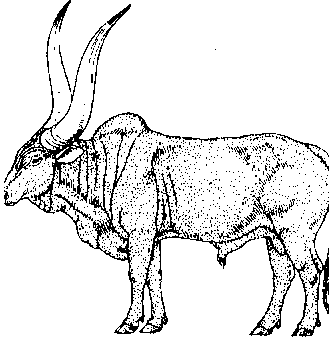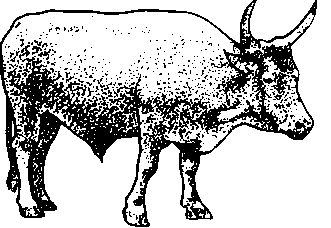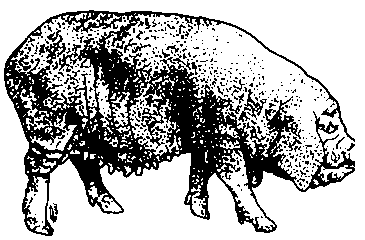FAO Fact sheet on the conservation of domestic animal genetic resources
Whether they are used in traditional farming, conventional or modern breeding or genetic engineering, the genetic resources of animals are a global asset of inestimable value to humankind. As genetic diversity erodes, our capacity to maintain and enhance livestock productivity and sustainable agriculture decreases, along with the ability to respond to changing conditions.
Agrobiodiversity holds the key to increasing food security and improving the human condition.
ANIMAL GENETIC RESOURCES include all species, breeds and strains that are of economic, scientific and cultural interest to humankind for agriculture, both now and in the future. Common agricultural species include sheep, goats, cattle, horses, pigs, buffalo and chickens, but there are many other domesticated animals such as camels, donkeys, elephants, reindeer, rabbits and rodents species that are important to different cultures and regions of the world.
Animal domestication began some 10 000 years ago when people began selecting animals for food, fibre, work power and other agricultural uses. Livestock provide valuable products, such as hides, wool and manure, that are important both for subsistence and as sources of income for rural communities. Livestock process forage and crop waste, inedible to humans, into nutritionally important food products. Approximately 40 percent of the total land available in developing countries can be used only for some form of forage production. An estimated 12 percent of the world's population live in areas where people depend almost entirely on products obtained from ruminant livestock- cattle, sheep and goats.
Centuries of human and natural selection have resulted in thousands of genetically diverse breeds of domestic animals adapted to a wide range of environmental conditions and human needs. Some are resistant to parasites or disease, for example, while others are adapted to humidity or drought or extremes of heat and cold. Animal genetic diversity, represented by this wide range of breeds, is essential to sustain the productivity of agriculture.
Animals account for 19 percent of the world's food basket directly, but they also provide draught power and fertilizer for crop production, bringing their overall contribution up to 25 percent. In addition, livestock serve as a very important form of cash reserves in many of the mixed farming systems. Taking this into account, animals contribute an estimated 30 percent of total human requirements for food and agriculture.
A sinking ark
In Europe, half of the breeds that existed at the turn of the century have become extinct; a third of the remaining 7 70 breeds are in danger of disappearing over the next 20 years. In Germany, for example, only 5 out of at least 35 indigenous breeds of cattle remain In North America, over one-third of all breeds of livestock and poultry are considered rare or in decline.
A great variety of breeds has been developed since domestication, particularly in Europe and Asia, but many are now threatened with extinction.
Ankole

Much less is known about breeds in the developing world. Domestic animal diversity is greatest in the developing world. Asia, for instance, is home to more than 140 breeds of pig, while North America can claim only 19.
Based on preliminary data, FAO predicts that 28 percent of livestock breeds are now at risk of extinction, and the current loss rate is estimated at one breed per week. and more than half of these breeds are likely to be found in developing countries.
Worldwide, the greatest threat to domestic animal diversity is the highly specialized nature of modern livestock production. In the developed world, commercial livestock farming is based on very few breeds that have been selected for the intensive production of meat, milk or eggs at high feeding levels in highly controlled conditions. The spread of intensive, high-input production systems to the developing world places thousands of native breeds at risk. Commercial breeds imported from North America and northern Europe are usually unable to sustain high production in less hospitable environments. They require intensive management and high levels of inputs such as highly digestible, high-protein feed, medication and high levels of management. Introduction of intensive animal production creates dependency on imported technologies: it is neither affordable nor sustainable for most farmers in the developing world.
After thousands of generations of controlled interbreeding most domesticated animals no longer have wild relatives from whom germplasm can be obtained. When a breed becomes extinct, an already narrow genetic base shrinks irreversibly. The small number of commercial breeds suited to intensive production do not offer an adequate genetic reservoir for the future. Their genetic base reflects the emphasis on maximizing production The turkey that is mass-produced on factory farms in North America and Europe, for example, has been selected for such a meaty breast that it can no longer breed unassisted. This broad-breasted breed - which accounts for 99 percent of all turkeys in the United States today-would become extinct in one generation without human assistance in the form of artificial insemination.
What value animal genetic diversity?
The Genetic diversity presently found in domestic animal breeds allows farmers to select stocks or develop new breeds in response to changes in the environment, threats of disease, new knowlege of human nutrition requirements, changing market conditions and societal needs, all of which are largely unpredictable. Indigenous livestock breeds often possess valuable traits such as disease resistance, high fertility, good maternal qualities, unique product qualities, longevity and adaptation to harsh conditions and poor quality feed, all desirable qualities for low-input, sustainable agriculture.
N'Dama

The Taihu pigs of China, for instance, offer valuable traits for swine breeders worldwide. This group of pigs have thick, wrinkled skin and long, droopy ears. They can use a high proportion of forage foods in their diet. The adult pig has little lean meat-whence the Chinese passion for sucking pig. But Taihu pigs reach sexual maturity in just 64 days, are extraordinarily fertile producing an average litter of 16 piglets compared to only 10 for Western breeds, and Taihu pig produce juicy, tasty meat. Researchers in Europe and the United States are exploring how to incorporate these beneficial qualities into commercial breeds. A British company, National Pig Development, has already produced a commercial hybrid of the Meishan, one of seven strains of Taihu pig. Announced in 1992, it combines the fecundity and meat quality trait of the traditional Chinese breed with a higher lean meat content.
Taihu pig

Conserving genetic diversity
There is already less genetic diversity in farm animals than in crop plant species and almost a third of the remaining animal genetic resources are currently at risk. In 1992, FAO launched a comprehensive programme for the global conservation of animal genetic resources. It includes:
· a global inventory of animal genetic resources including a database to characterize and enumerate all breeds of livestock available for use in agriculture.· action to identify breeds at risk of extinction as well as ways of protecting them.
· promotion of programmes in developing countries to conserve endangered breeds in their native habitats. The aim is to enhance the attraction of indigenous breeds at risk of being substituted by imported breeds often brought in without considering local conditions or sustainability.
· improvement of livestock breeding capacities in the developing world. In particular, new technologies will be used to identify livestock diversity and the specific genes responsible for valuable traits.
FAO is exploring the possibility of establishing a global centre for domestic animal genetic diversity to serve as the focus for regional and national efforts to overcome the present erosion of these irreplaceable resources and to promote their effective and sustained use Conservation of animal genetic diversity is essential to global food security and to protect our ability to meet the challenges of the future.
|
For information contact: Telephone: (39 - 6) 5225 - 3364 |